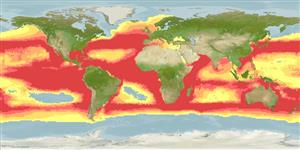Classification / Names
Common names from other countries
Main reference
Size / Weight / Age
Max length : 573 cm TL male/unsexed; (Ref. 106604); 549.0 cm TL (female); common length : 450 cm TL male/unsexed; (Ref. 5217); max. published weight: 348.0 kg (Ref. 40637); max. reported age: 25 years (Ref. 81241)
Length at first maturity
Lm 303.0, range 226 - 400 cm
Environment
Marine; pelagic-oceanic; oceanodromous (Ref. 51243); depth range 0 - 650 m (Ref. 106604), usually 0 - 200 m (Ref. 55168)
Climate / Range
Subtropical, preferred 26°C (Ref. 107945); 67°N - 58°S, 180°W - 180°E (Ref. 54279)
Distribution
Cosmopolitan in temperate and tropical seas (Ref. 6871, 58085). Population considered reduced (R) in the US Atlantic waters; lower risk/conservation dependent (LR/CD) in US Pacific waters; data deficient (DD) in the rest of Atlantic and rest of Pacific (Ref. 12451). Highly migratory species, Annex I of the 1982 Convention on the Law of the Sea (Ref. 26139).
Countries | FAO areas | Ecosystems | Occurrences | Introductions
Short description
Dorsal
spines
(total): 0;
Dorsal
soft rays
(total): 0;
Anal
spines: 0;
Anal
soft rays: 0. A large thresher with relatively small eyes, curved, narrow-tipped pectoral fins, a narrow-tipped caudal fin, and a conspicuous white patch over the pectoral fin bases (Ref. 5578). Second dorsal origin well behind the rear tip of the pelvic fin (Ref. 559). Upper lobe of caudal fin very long and strap-like, about as long as or longer than length of rest of shark; lower lobe short but well developed (Ref. 13570). Brown, grey, blue-grey, or blackish on back and underside of snout, lighter on sides and abruptly white below; a white area extends from the abdomen over the pectoral-fin bases; pectoral-, pelvic-, and dorsal fins blackish, white dots sometimes present on pectoral-, pelvic-, and caudal- fin tips (Ref. 13570).
IUCN Red List Status (Ref. 115185)
Human uses
Fisheries: commercial; gamefish: yes
More information
ReferencesAquacultureAquaculture profileStrainsGeneticsAllele frequenciesHeritabilityDiseasesProcessingMass conversion
Tools
Special reports
Download XML
Internet sources
Estimates of some properties based on models
Phylogenetic diversity index
PD50 = 0.7500 many relatives (e.g. carps) 0.5 - 2.0 few relatives (e.g. lungfishes)
Trophic Level
4.5 ±0.0 se; Based on diet studies.
Resilience
Very Low, minimum population doubling time more than 14 years (K=0.1; tm=5-7; tmax=19; Fec=2-4)
Vulnerability
High to very high vulnerability (68 of 100)
Price category
